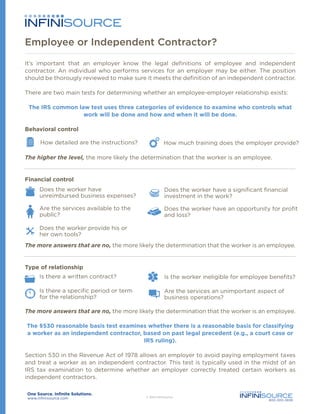
Employee or Independent Contractor?
- 1. Employee or Independent Contractor? It’s important that an employer know the legal definitions of employee and independent contractor. An individual who performs services for an employer may be either. The position should be thorougly reviewed to make sure it meets the definition of an independent contractor. There are two main tests for determining whether an employee-employer relationship exists: The IRS common law test uses three categories of evidence to examine who controls what work will be done and how and when it will be done. Behavioral control How detailed are the instructions? How much training does the employer provide? The higher the level, the more likely the determination that the worker is an employee. Financial control Does the worker have unreimbursed business expenses? Does the worker have a significant financial investment in the work? Are the services available to the public? Does the worker have an opportunity for profit and loss? Does the worker provide his or her own tools? The more answers that are no, the more likely the determination that the worker is an employee. Type of relationship Is there a written contract? Is the worker ineligible for employee benefits? Is there a specific period or term for the relationship? Are the services an unimportant aspect of business operations? The more answers that are no, the more likely the determination that the worker is an employee. The §530 reasonable basis test examines whether there is a reasonable basis for classifying a worker as an independent contractor, based on past legal precedent (e.g., a court case or IRS ruling). Section 530 in the Revenue Act of 1978 allows an employer to avoid paying employment taxes and treat a worker as an independent contractor. This test is typically used in the midst of an IRS tax examination to determine whether an employer correctly treated certain workers as independent contractors. www.infinisource.com 800-300-3838
- 2. To satisfy the §530 reasonable test, you must fill all three of these requirements: Reasonable basis Substantive consistency You must show that you reasonably relied on a court case or IRS ruling issued to you or that a past IRS audit did not force you to reclassify workers. Alternatively, you can show that you treated workers as independent contractors because a significant segment of your industry does the same. Finally, you can simply show some other reasonable basis (e.g., relying on the advice of an attorney or accountant with knowledge of the facts). You must have treated these workers, and any similar workers, as independent contractors in the past. Reporting consistency This means filing Form 1099-MISC for every year that you paid the worker $600 or more. Common Law Employees Independent Contractors Follows employer’s instructions Agrees on job specifications Trains within the company Obtains own training Hired, supervised, paid by employer Hires, supervises and pays own staff Works for only one employer Available to the general public Employer sets work schedule Develops own work schedule Employer furnishes materials Furnishes own materials Business expenses paid by employer Pays own business expenses Personally performs the work May subcontract work Is an integral part of the company Provides peripheral services Works on a regular basis Works at irregular intervals Usually works 40 hours a week Usually works varied schedule Is paid by the hour, week or month Is paid by the completed job Works at employer’s premises Works anywhere www.infinisource.com 800-300-3838
